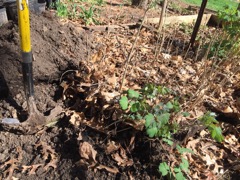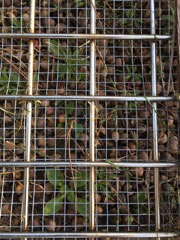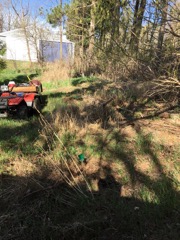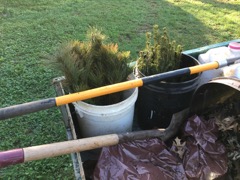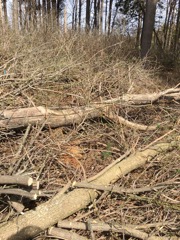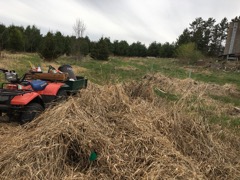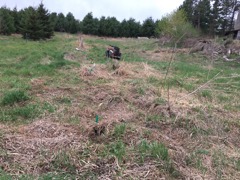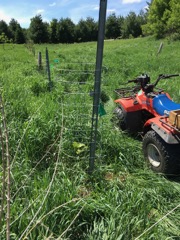Treenut's Forest Notes for 2018
2018 Farm Notes:
May 6-8, 2018: Transplant Trees - Filling some gaps in the wood lot.
Tree Order from DNR
Species Age Bulk # Ordered Total
PW3 Pine, White 3-0 200 $115.40
SW2 Spruce, White 2-0 100 $49.90
Total 300 $165.30
Trees from my 'garden' nursery.
~ 50 White Oak and Red Oak.
Remember: last spring (2017) I was clearing out the remaining seedlings from my seed bed.. It had gotten too late to move these into the woods so I potted most into D80 tubes or 6" pots. On a few, the taproot was too big for a pot so I dug them into my garden and gave them TLC for the summer.
Now I've dug these at bud break and brought them to the farm to plant along with the pine and spruce.
Seedbed survived the winter intact (oh BTW)
This seed bed survived the winter and has so far resisted any attempts to enter by hungry squirrels and other seed lovers.
Day one of planting:
The first day is always the most stressful. Even though I only have 300 plus trees to plant, I am uncertain if I can get them all planted in the limited time I have at the farm. This trip I only have 3 actual working days because I have a Double Header scheduled for Wednesday afternoon (game time 4:00 PM) in Sun Prairie.
I spent day one filling in gaps in the stand just north of the homestead (the old windbreak). This area desperately needs alternatives to the natural scrub that has grown in to replace the disaster that happened to the original stand (caused both by loggers and by nature).
The first night is always fitful with worry and I don't sleep very well, get up too early, and am aching and sore from the first day. The good news is NO TICS -- so far. They are reported to be out and very hungry. Maybe it's the spray that's helping (again I say 'so far').
The first day was warm and sunny. I began in the west end of the old windbreak and filled in gaps between those transplants from 3 years ago that have been successful. This took about 50 pine and 25 spruce.
I planted more oak along the south edge of the break; 30 to 50 feet apart. This was based on the success of the one oak that has done so well in it's cage. I will cage the new ones as well. This is the only way to insure the deer keep away. I extended this row of oak east of the shed and past the 'guest house' as seen above.
These 3 year old white pine have beautiful root systems. The 2 year old spruce are much smaller and have short roots. I am using the spruce where I cannot get a deep hole for whatever reason.
NOTE: the ground is perfect for digging and is plenty wet for the trees to get a good start. In many places the soil is so wet that it sticks to the shovel.
Okay, here's the deal with this project:
If you've been following this site you know that this 5 acre stand (old 'windbreak') has had many problems over the years: First, it was not thinned soon enough. When we contracted to have it thinned the loggers LEFT every third row (where they followed rows at all). They were supposed to TAKE every third row. Mostly they just high-graded the stand (took all the best trees and left the junk). So we were left with lots of spindly tall trees and big holes in the stand.
In the years since, every wind storm knocks down a few more trees and there has been no natural regeneration of the pines.
The spaces have been filled by Mother Nature with elderberry, box elder, buckthorn, ash, scrub elm, chokecherry, and blackberry to name a few.
Over these years I had been so busy trying to establish the main forest on this farm that I hadn't paid much attention to this little stand. When I had some time I would cut brush that had gotten big and spray round-up on the new sprouts. While I was paying attention to the brush, some of the ash, box elder, and elm had grown up to 20 feet.
Three years ago I decided that I really wanted pine in this stand because -- well because that's what my dad had planted here and I wanted to return it to it's former form. So I planted 150 pine and spruce in part of the stand that I'd been sort of keeping up with clearing out the brush. Then I cut down these 'junk' hardwoods that had grown tall so they wouldn't shade out my new trees.
And then I hoped the dear wouldn't eat everything and some would out-compete the brush.
Last summer I had disparaged that all my new trees were dead because I couldn't find many in the underbrush. Then last winter -- after the leaves had died and fallen -- I could see all the new pine and I was amazed at how well everything was shooting up. So I ordered 300 more transplants for this spring.
Today, while I was planting these trees I looked around and realized that there were hardly any evergreens left in this stand. This used to be a beautiful pine forest and now it's bare. As think back over the years that I've been clearing brush out of here I wonder what I was thinking. Here I'm destroying everything that Mother Nature is trying to do and I'm NOT providing any alternatives of my own.
How republican of me -- right?
So now I am offering alternatives in the form of pine and spruce transplants. We'll see if this turns out to be a good idea or not.
more to follow, stay tuned
Day two of planting:
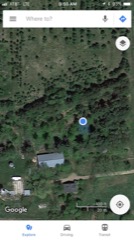
Map location where I am planting.
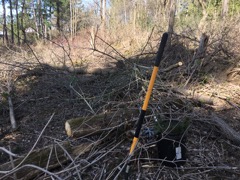
Keep the rows straight - more or less.
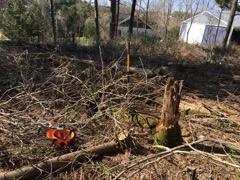
Cut brush and plant in duff
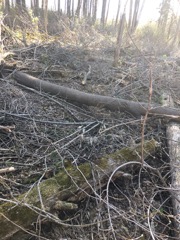
Will this bramble keep the deer away from my new trees?
Clearing brush and felled trees.
Now that I've filled in the gaps, I need to expand my efforts towards the east and north.
On an earlier trip I felled a few larger junk trees and cut the brush down to the ground (within 3 feet of the ground) so that it will rot quickly. I planted right in the trash and hope that it will be too hard for the deer to walk and they will leave the new trees alone.
This area is also populated by bushy White Elderberry. I whack these down and plant among this trash as well.
Slow going
It's a real pain to walk in this stuff but I keep the rows of new trees straight the best I can. This helps when I am trying to find the trees if I need to help release them later on. If the deer have half the trouble I have getting through here, then these trees should be fine.
All Pine and Spruce are planted. Now it's up to Mother Nature
a little rain please...
Day three of planting:
A few Oak seedlings from the garden nursury.
Last fall I transplanted a few soft maple into this lower field. The deer imediately nipped off the buds so I put cages around each tree. Now I've added oak to extend the rows of maple. I gave each transplant a shot of plant food and a spritz of deer repelant. I've run out of time on this trip so I will put cages up next visit.
The main problem down in this field has been the rich soil and the extremely tall grass that competes with the young trees. The main problem in helping these trees grow is to FIND them during the season. I have marked each tree with a wire flag and on my next trip I will put up fencing and real fence posts to both mark and protect them.
I believe most of these Oak are White Oak so they should tolerate the wet spring time in this bottom land.
[Back to top]
June 1: Release, marking, and cages.
Here are these Oak transplants one month later. They are growing nicely and for some reason the Deer have left them alone (mostly).
I am putting in posts and setting cages around each tree. This is against common practice for foresters (usually we want to plant it and forget it) but this area has been very tough to get anything established. I have tried planting here three or four times with no success. Either the grass has been too thick and tall or the deer have feasted too heavily (or both -- probably both). So this time I am doing everything I can to insure success for these Oak (and some soft Maple from last fall).
These cages and posts will not only protect from deer browse but, perhaps more importantly, they will mark the tree so that I can find it during the growing season. This lowland is so fertile, and the grass and weeds grows so tall and lush, that it has been nearly impossible to find young trees after they have been planted.
